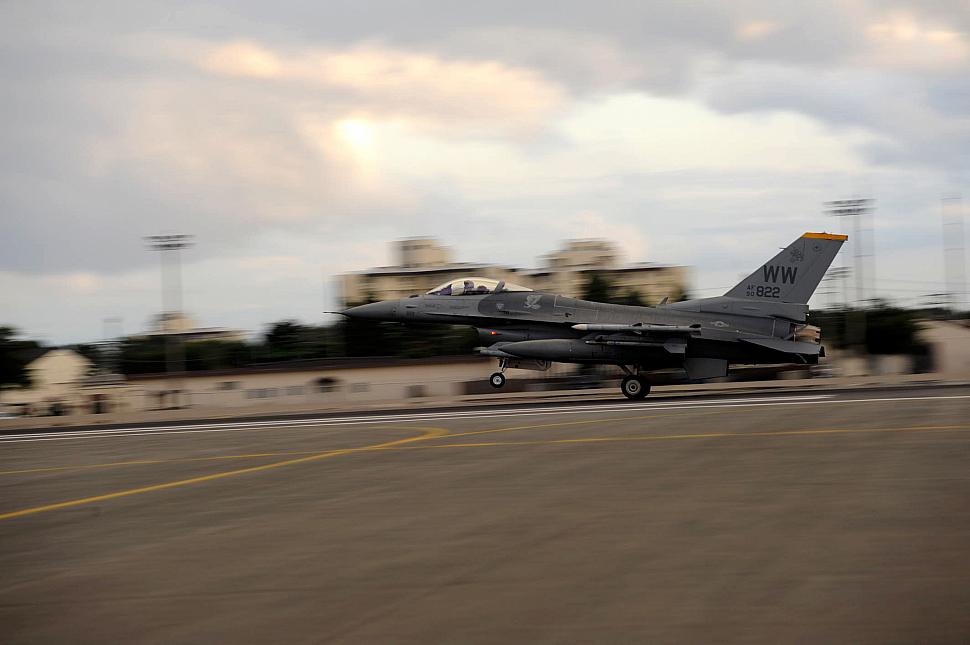Fighter Jet News
F-16 Fighting Falcon News
35th FW reaches 2012 flying hour quota
October 3, 2012 (by
A1C Kenna Jackson) -
While sitting in the cockpit of an F-16 Fighting Falcon aircraft, Capt. Ruben Amezaga, 14th Fighter Squadron C-Flight commander, glanced at the clock as the sun lowered and its pinkish-orange glow signaled the end of another day at Misawa.

Unfortunately for Amezaga, it wasn't like any other day. It was the last day for the base to close out their flying hour program for the fiscal year 2012, Sept. 26, 2012, to be exact. On top of that, Amezaga's jet was scheduled as the last aircraft to touch down on the runway. Suffice to say he was a bit pressured to make sure he completed his mission according to plan.
"I kept checking the clock, focused on making the deadline. I just kept thinking to myself, I've got to land on time," said Amezaga.
The Pacific Air Force flying hour program has a set number of sorties or flying hours for each pilot. This number is assigned to ensure they are combat ready and F-16 mission capable. The program allows pilots to fly over their allocated flying hours, but not under them. Being unable to fulfill set flying hours means the loss of money and hours, which will be reallocated to another fighter wing.
"Perfectionism is just part of who we are," said Amezaga, with modest pride shortly after landing the jet.
Maj. Robert Carden, 35th Operations Support Squadron wing scheduling flight commander, stated he was just as proud as the pilot.
"I owe everyone a thank you. It takes a tremendous amount of teamwork to do our job and to keep the program working smoothly," said Carden.
The U.S. Air Force allotted the 35th Fighter Wing $54,042,400.00 for its Flying Hour Program, roughly an average of $8,000.00 per hour of air time that is used to maintain combat capabilities of the pilots, Airmen and aircraft. It's because of this money and the Airmen and pilot's mentality that they closed out their flying hours with 4,400 sorties flown and 6,700 hours of flight time generated from Oct. 1, 2011 to Sept. 30, 2012.
"Not only are the pilots being pushed to maintain their combat capability, but maintainers and support agencies are keeping up with their combat proficiency through their own aspect training," said Carden.
From the moment the jets' wheels leave the ground to when they touch down onto a runway and everything in between, maintainers are using that time to keep up their training.
"It's one big cycle; money equals training equals mission readiness," said Carden. "Basically, we get money from the government, Airmen and pilots get the training they need to maintain their combat capabilities and homeland security is ensured. Without this program, homeland security could be threatened."

USAF F-16C block 50 #90-0822 from the 14th FS lands on the flightline at Misawa AB on September 26th, 2012. The PACAF flying hour program is used to maintain the budget for fighter jets. Congress designates the number of flying hours for tactical fighter bombers per fiscal year. [USAF photo by A1C. Kenna Jackson]
"I kept checking the clock, focused on making the deadline. I just kept thinking to myself, I've got to land on time," said Amezaga.
The Pacific Air Force flying hour program has a set number of sorties or flying hours for each pilot. This number is assigned to ensure they are combat ready and F-16 mission capable. The program allows pilots to fly over their allocated flying hours, but not under them. Being unable to fulfill set flying hours means the loss of money and hours, which will be reallocated to another fighter wing.
"Perfectionism is just part of who we are," said Amezaga, with modest pride shortly after landing the jet.
Maj. Robert Carden, 35th Operations Support Squadron wing scheduling flight commander, stated he was just as proud as the pilot.
"I owe everyone a thank you. It takes a tremendous amount of teamwork to do our job and to keep the program working smoothly," said Carden.
The U.S. Air Force allotted the 35th Fighter Wing $54,042,400.00 for its Flying Hour Program, roughly an average of $8,000.00 per hour of air time that is used to maintain combat capabilities of the pilots, Airmen and aircraft. It's because of this money and the Airmen and pilot's mentality that they closed out their flying hours with 4,400 sorties flown and 6,700 hours of flight time generated from Oct. 1, 2011 to Sept. 30, 2012.
"Not only are the pilots being pushed to maintain their combat capability, but maintainers and support agencies are keeping up with their combat proficiency through their own aspect training," said Carden.
From the moment the jets' wheels leave the ground to when they touch down onto a runway and everything in between, maintainers are using that time to keep up their training.
"It's one big cycle; money equals training equals mission readiness," said Carden. "Basically, we get money from the government, Airmen and pilots get the training they need to maintain their combat capabilities and homeland security is ensured. Without this program, homeland security could be threatened."
Courtesy of 35th Fighter Wing Public Affairs
Related articles:
Forum discussion:
Tags
- Kunsan zeroes out 2010 flying hours (2010-09-30)
- Misawa fighter pilots prove best in AF (2008-10-15)
- F-16 Fighting Falcon news archive
Forum discussion:
- Start a discussion about this article in the F-16.net forum.
Tags
